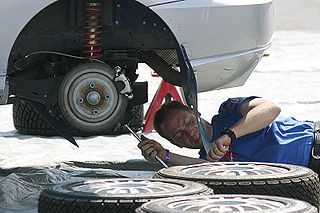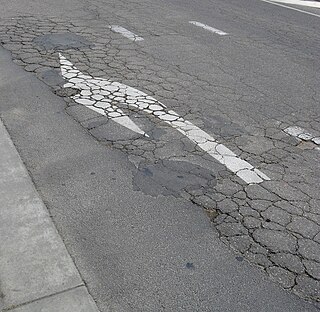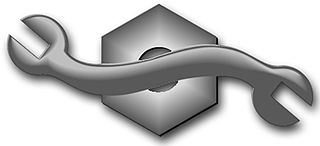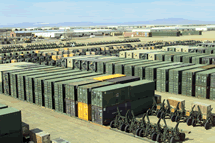
Cost accounting is defined by the Institute of Management Accountants as "a systematic set of procedures for recording and reporting measurements of the cost of manufacturing goods and performing services in the aggregate and in detail. It includes methods for recognizing, allocating, aggregating and reporting such costs and comparing them with standard costs". Often considered a subset of managerial accounting, its end goal is to advise the management on how to optimize business practices and processes based on cost efficiency and capability. Cost accounting provides the detailed cost information that management needs to control current operations and plan for the future.

The technical meaning of maintenance involves functional checks, servicing, repairing or replacing of necessary devices, equipment, machinery, building infrastructure, and supporting utilities in industrial, business, and residential installations. Over time, this has come to include multiple wordings that describe various cost-effective practices to keep equipment operational; these activities occur either before or after a failure.
A line-replaceable unit (LRU), lower line-replaceable unit (LLRU), line-replaceable component (LRC), or line-replaceable item (LRI) is a modular component of an airplane, ship or spacecraft that is designed to be replaced quickly at an operating location. The different lines (distances) are essential for logistics planning and operation. An LRU is usually a sealed unit such as a radio or other auxiliary equipment. LRUs are typically assigned logistics control numbers (LCNs) or work unit codes (WUCs) to manage logistics operations.
Total cost of ownership (TCO) is a financial estimate intended to help buyers and owners determine the direct and indirect costs of a product or service. It is a management accounting concept that can be used in full cost accounting or even ecological economics where it includes social costs.

In systems engineering, information systems and software engineering, the systems development life cycle (SDLC), also referred to as the application development life cycle, is a process for planning, creating, testing, and deploying an information system. The SDLC concept applies to a range of hardware and software configurations, as a system can be composed of hardware only, software only, or a combination of both. There are usually six stages in this cycle: requirement analysis, design, development and testing, implementation, documentation, and evaluation.
Purchasing is the procurement process a business or organization uses to acquire goods or services to accomplish its goals. Although there are several organizations that attempt to set standards in the purchasing process, processes can vary greatly between organizations.
Reliability engineering is a sub-discipline of systems engineering that emphasizes the ability of equipment to function without failure. Reliability describes the ability of a system or component to function under stated conditions for a specified period. Reliability is closely related to availability, which is typically described as the ability of a component or system to function at a specified moment or interval of time.
Integrated logistics support (ILS) is a technology in the system engineering to lower a product life cycle cost and decrease demand for logistics by the maintenance system optimization to ease the product support. Although originally developed for military purposes, it is also widely used in commercial customer service organisations.

An auto mechanic is a mechanic who services and repairs automobiles, sometimes specializing in one or more automobile brands or sometimes working with any brand. In fixing cars, their main role is to diagnose and repair the problem accurately and quickly. Seasoned auto repair shops start with a (Digital) Inspection to determine the vehicle conditions, independent of the customers concern. Based on the concern, the inspection results and preventative maintenance needs, the mechanic/technician returns the findings to the service advisor who then gets approval for any or all of the proposed work. The approved work will be assigned to the mechanic on a work order. Their work may involve the repair of a specific part or the replacement of one or more parts as assemblies. Basic vehicle maintenance is a fundamental part of a mechanic's work in modern industrialized countries, while in others they are only consulted when a vehicle is already showing signs of malfunction.

Predictive maintenance techniques are designed to help determine the condition of in-service equipment in order to estimate when maintenance should be performed. This approach promises cost savings over routine or time-based preventive maintenance, because tasks are performed only when warranted. Thus, it is regarded as condition-based maintenance carried out as suggested by estimations of the degradation state of an item.
Reliability-centered maintenance (RCM) is a concept of maintenance planning to ensure that systems continue to do what their user require in their present operating context. Successful implementation of RCM will lead to increase in cost effectiveness, reliability, machine uptime, and a greater understanding of the level of risk that the organization is managing.
Maintenance testing is a test that is performed to either identify equipment problems, diagnose equipment problems, or confirm that repair measures have been effective. It can be performed at either the system level, the equipment level, or the component level.

Construction mechanic is a United States Navy occupational rating.
Medical equipment management is a term for the professionals who manage operations, analyze and improve utilization and safety, and support servicing healthcare technology. These healthcare technology managers are, much like other healthcare professionals referred to by various specialty or organizational hierarchy names.
Whole-life cost is the total cost of ownership over the life of an asset. The concept is also known as life-cycle cost (LCC) or lifetime cost, and is commonly referred to as "cradle to grave" or "womb to tomb" costs. Costs considered include the financial cost which is relatively simple to calculate and also the environmental and social costs which are more difficult to quantify and assign numerical values. Typical areas of expenditure which are included in calculating the whole-life cost include planning, design, construction and acquisition, operations, maintenance, renewal and rehabilitation, depreciation and cost of finance and replacement or disposal.
Equipment rental, also called plant hire in some countries, is a service industry providing machinery, equipment and tools of all kinds and sizes for a limited period of time to final users, mainly to construction contractors but also to industry and individual consumers. Renting can be defined as paying someone for the use of something for temporary or short-term purposes.

Sierra Army Depot (SIAD) is a United States Army post and military equipment storage facility located near the unincorporated community of Herlong, California. It was built in 1942 as one of several ammunition storage facilities located far enough inland to be safe from Japanese attack, yet close enough to western military posts and ports to facilitate shipment of supplies. The site also met the requirement that the depot be in a dry and isolated area.
A spare part, spare, service part, repair part, or replacement part, is an interchangeable part that is kept in an inventory and used for the repair or refurbishment of defective equipment/units. Spare parts are an important feature of logistics engineering and supply chain management, often comprising dedicated spare parts management systems.
Test and evaluation master plan (TEMP) is a critical aspect of project management involving complex systems that must satisfy specification requirements. The TEMP is used to support programmatic events called milestone decisions that separate the individual phases of a project. For military systems, the level of funding determines the Acquisition Category and the organization responsible for the milestone decision.
Maintenance Philosophy is the mix of strategies that ensure an item works as expected when needed.






